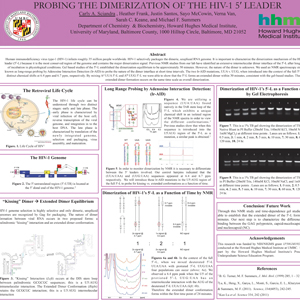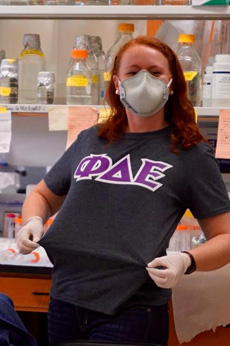Biology
“Structure and Mechanism of an RNA Thermosensor”
RNA thermosensors (RNATs) are non-coding RNA molecules found in the 5’-untranslated region (5’-UTR) of mRNAs, which regulate the expression of the downstream gene as a function of temperature. RNATs are proposed to adopt a structure that occludes the ribosome-binding site (RBS) at low temperature, thus preventing translation. At elevated temperatures, the RBS is exposed, promoting translation. We are interested in the RNAT found in the 5’-UTR of prfA, a transcriptional activator that regulates the expression of a number of virulence genes in Listeria monocytogenes, which is an important human pathogen. Other well-characterized RNATs, such as 4U, ROSE, and css, all have elucidated mechanisms. The stem of these RNATs gradually melts as a function of increasing temperature, resulting in a gradient of protein expression. The prfA RNAT, however, appears to utilize a different mechanism where a slight temperature change results in a large functional change. Between 30 °C and 37 °C, there is no expression of PrfA, but at 38 °C there is significant amounts of PrfA expression. We hypothesize that at elevated temperature, there is a large structural rearrangement that occurs, accounting for the apparent “switch” functionality. Using NMR spectroscopy we will probe the structure and mechanism of the prfA RNAT at different temperatures. Using a selective deuteration approach, we have obtained high-quality 1D proton and 2D proton-proton NOESY spectra of the 110-nt prfA RNAT at various temperatures. These preliminary spectra indicate that there is a large structural change over a narrow temperature window (3 °C). A detailed understanding of the structure and mechanism of the prfA RNAT will allow for the targeted design of a novel RNAT that functions at either higher or lower temperatures. Additionally, since PrfA controls a number of virulence genes in Listeria monocytogenes, it is a promising target for therapeutic development. The three-dimensional structure of the prfA RNAT will facilitate the design of small molecules that can bind to and “turn off” the prfA RNAT, even at elevated temperatures, which would normally promote translation.

What research experiences have you had?
I have been working in Dr. Michael Summers Lab for the past year and a half.
How did you find the research opportunity?
I had a friend who worked in the lab so I took a chance and emailed Dr. Summers to see if he had a position open and he emailed back to offer me an interview.
Who is your mentor for your research?
Dr. Michael Summers
Do you get course credit for this work?
I get paid to work in his lab.
What academic background did you have before you started?
All of my foundational and upper level chemistry and biology courses.
How did you learn what you needed to know to be successful in this project?
By reading papers, asking as many questions I could come up with, and truthfully just immersing myself in the research I understand as much as I could.
What was the hardest part about your research?
Understanding and analyzing the NMR data collected. It is very complex and often takes graduate students a long time before they understand it.
What was the most unexpected thing?
Before working in lab I knew I wanted to get an M.D., but through my lab experience I realized I could not do without also getting a Ph.D.
How does this research experience relate to your work in other classes?
A lot of what I learn in class I actually learned first in lab because I started off in lab my sophomore year before classes got hard. So its nice when we learn something new and I get excited because I learned it in lab first. It is very rewarding to be able to put the book information learned into practical use in the lab.
What did you gain from presenting your work at ABRCMS?
I gained a lot of confidence in my presentation skills and had the ability to network to many established professors and doctors at the conference.
What is your advice to other students about getting involved in research?
Don’t be afraid to email a professor whose research you are interested in. The worst they can do is say that they do not have space.
What are your career goals?
I am going to pursue and MD/Ph.D. after my undergraduate career.
What else are you involved in on campus?
- I am the secretary/ Risk Management Officer of Phi Delta Epsilon International Medical fraternity
- I am an Organic Chemistry Learning Assistant
- I am a Biology 141 Supplemental Instructor
11/30/2016
